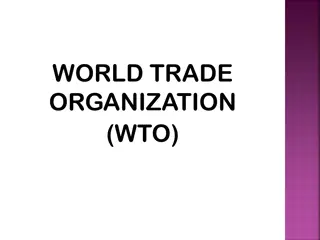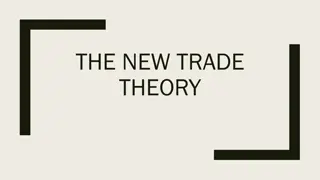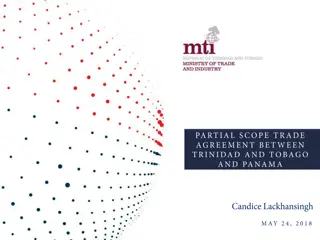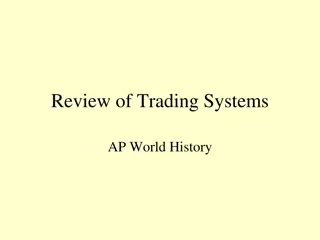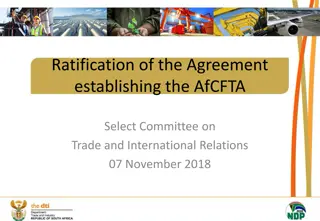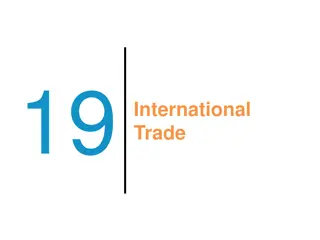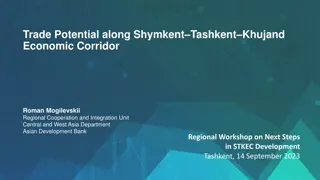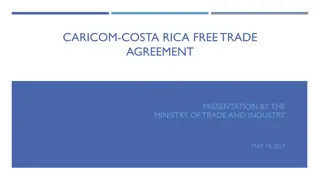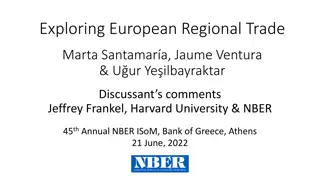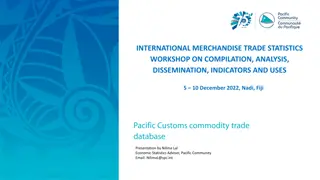Power Trade Agreement: Sher Singh Bhat
The necessity of a power trade agreement with India to address seasonal surpluses and deficits in the energy sector. Learn about existing capacities, demand peaks, and strategies to market surplus power effectively. Find solutions to bridge the gap between wet and dry seasons, highlighting the importance of harnessing hydro-potential for sustainable energy trading.
Download Presentation

Please find below an Image/Link to download the presentation.
The content on the website is provided AS IS for your information and personal use only. It may not be sold, licensed, or shared on other websites without obtaining consent from the author.If you encounter any issues during the download, it is possible that the publisher has removed the file from their server.
You are allowed to download the files provided on this website for personal or commercial use, subject to the condition that they are used lawfully. All files are the property of their respective owners.
The content on the website is provided AS IS for your information and personal use only. It may not be sold, licensed, or shared on other websites without obtaining consent from the author.
E N D
Presentation Transcript
POWER TRADE POWER TRADE AGREEMENT AGREEMENT Sher singh bhat
POWER TRADE AGREEMENT IS OUR NEED POWER TRADE AGREEMENT IS OUR NEED RATHER THAN CHOICE RATHER THAN CHOICE
TYPICAL FLOW TYPICAL FLOW DURATION DURATION CURVE AND DESIGN PLANT CAPACITY CURVE AND DESIGN PLANT CAPACITY Series 1 70 60 50 M^3/S 40 Series 1 30 Installed capacity at Q25: 35 MW 20 Installed capacity at Q40: 20 MW 10 Installed capacity at Q65: 12 MW Firm power 5 MW 0 0 5 10 15 20 25 30 35 40 45 50 55 60 65 70 75 80 85 90 95 100 % OF TIME
SEASONAL SURPLUS AND DEFICITS DUE TO TYPICAL FLOW DURATION CURVE 3Q/3P Import Storage Diesel Q (P) July December June
Balance 2018/19 considering Under Construction Balance 2018/19 considering Under Construction Particulars Hydro Thermal Others Total Existing capacity 722 53 775 Capacity addition NEA 136 NEA Subsidiary and associate companies 725 Other IPPs 296 Total ongoing augmentation 1157 150 (imp) 1307 Altogether in 2018/19 1879 203 2082 Demand Peak 1907 Off peak 1050 Wet Season Balance Neck to neck About 1000 MW surplus 20 hrs. a day Dry season Available 750 Deficit 1200 MW Deficit 400 MW Load shed > 10 hrs.
IN BRIEF IN BRIEF Wet Season after 3-4 years Huge off peak surplus worth 20 BNR; if not marketed in X- Border market total loss to NEA Poor product so price may be too low even if marketed In both cases loss will have to be recovered by increasing tariff Dry Season after 3-4 years Large deficit and load shedding if not imported in large volume Current import worth 10 BNR, might go 25 BNR in 2018/19; Electricity import second highest So Power Trade Agreement with India is our NEED to: Market the Seasonal Surplus to keep down the effective retail tariff To import during deficit dry months and eliminate load shedding To harness hydro-potential and market power Otherwise only 2000 MW capacity in 2018/19 has become problem, what about 83000 MW.
X-BORDER TRADING OF ELECTRICITY (IN INDIAN MARKET)
TRADING OF ELECTRICITY IS TYPICAL TRADING OF ELECTRICITY IS TYPICAL Unlike other commodities, Trading of electricity needs special markets It is intangible commodity It cannot be stored and has to be consumed at the moment it is generated It needs a hard wire connection from generation to point of consumption It is not measurable at the custom point
INDIAN POWER SECTOR AND MARKET INDIAN POWER SECTOR AND MARKET CSGS SGS Public DISCOMS Private DISCOMS Large consumers IPP LONG TERM PPA Long term Bilateral IPP under Bidding Private Merchant Renewables Short term Traders Private Public DAM IEX/PXIL UI Joint Projects
DERIVED NEPALESE WISH LIST FOR PTA (1) DERIVED NEPALESE WISH LIST FOR PTA (1) Area Development of hydropower Issue PTA should have provisions to accelerate not regulate Analysis No outside intervention on how and when to develop Nepal s hydropower No provision acceptable that eclipses Nepal s water right on its territory, right on added value of water during the course of hydropower development PTA to ensure that export of electricity shall be only after meeting Nepal s domestic requirement in REAL TIME Domestic Requirements Accessibility in Indian Market PTA to ensure market for all generated power for design optimization at best use PTA should provide non- discriminatory access to Nepalese public and private generators in Indian market and transmission grid All tariff and non- tariff barriers on import/ export of electricity to be waived. Nepalese power to have access in all kinds of Indian markets ( Long term, short term and spot market) No direct or indirect special tariffs or special clearances on importable power in India PTA should ensure best market prices above cost of generation Product value of peak and off peak power be ensured Respective parties should be allowed to sign PPA in INR, USD or NR as per their mutual convenience Tariff
DERIVED NEPALESE WISH LIST FOR PTA (2) DERIVED NEPALESE WISH LIST FOR PTA (2) Area Market coupling Issue Perfect integration as common market but Nepalese consumers should not be exposed to catastrophic price hike in common market due to supply deficits. If Nepal is entering long term market, Nepal s export will not entertain market price hikes but Nepalese consumers will be exposed to it. So Nepalese consumers should be immunized from it. (How it will be done? Insulate domestic market? Then integration will be of different kind.) No risk of marketing in volume as well as in cost of generation Analytic note Risks PTA should not expose Nepal to FOREX Risk Net off gain to GON PTA should ensure definite predefined net off gain to GON on per unit of exported energy considering the concessions and incentives offered by the GON for development of hydropower. PTA should allow export of power by Nepal to a third country using Indian grid Third Country Sale
NEPALESE WISH MARKET NEPALESE WISH MARKET NEPAL N INDIA Bhutan Pakistan MM INDIAN MARKET Maldives Bangladesh Sri Lanka
DERIVED INDIAN WISH LIST FOR PTA DERIVED INDIAN WISH LIST FOR PTA Area Development of hydropower Issue India wishes to be involved in the planning and development of hydropower in Nepal through cooperation agreement It will ensure the planning and development of domestic transmission system in Nepal, X-Border transmission system and expansion and reinforcement of Indian transmission system Indian public/private entities should get preference in development of hydropower in Nepal. Entry of Nepalese power in Indian market should be step wise in regulated volumes so that it is not detrimental to the Indian market and put the investments in India at risk. Large volume of Nepalese power should enter Indian market through a single window instead of mushroomed numerous parties in Nepal getting direct entry Nepalese power should enter the long term market through single window and this single window in India then take it to the Indian market on market portfolio basis No direct or indirect special tariffs on exportable power by Nepal (royalty and permission for export) Nepalese power should enter the long term market at cost of generation Joint group for estimation of cost of generation price at which power will enter into India. In case Nepal needs to import, it should purchase it from short term Indian market No direct export through Indian transmission system, it enters India through single window, becomes Indian power, enters Indian market and then may go to Bangladesh as Indian power from market Market access Pricing Third country sale
INDIAN WISH MARKET INDIAN WISH MARKET Nepal Pakistan Bhutan India MARKET MM Maldives Bangladesh Cost of generation transaction Through Nodal Agencies Sri Lanka Transaction through market
NEPAL POSITION NEPAL POSITION Generation sector Public sector generator(s) for domestic requirements with seasonal surplus and deficits Private generators of small and medium size Large private generators directly targeting export market P2P Cooperation projects conceived for future All of these want access to Indian market by their own No country will allow such unplanned energy access Every country has its own energy security concerns The kind of PTA we conclude will guide the financing of projects We might have very good market accessibility but not suitable for financing Kind of wish list we have, asks merchant plants. Can we get them financed? Can we afford the volume and price risks of short term market? Can we ensure transmission for large volume of export in short term market? Very clear Hydropower marketing doesn t go that way (like potatoes). It has to go very much planned. Mostly it is long term market based. Most important is Wish lists of two sides should not be mutually exclusive, but complimentary. If it did not happen for last many years, will not happen for further many years if we don t compliment.
WHAT CAN WORK? WHAT CAN WORK? GATE 1: Long term guaranteed market Price and volume guaranteed Guided by co-operation Agreement GATE 2: Short term and spot market Financing not a Problem Long term market ( bid or bilateral Price regulated by CERC, and volume not guaranteed Integration of: Indian Public Sector Nepali Public Sector P2P Any private GATE 3: Short term or Spot market ( nothing guaranteed) Any private direct Any public direct Integrated surplus of public sector Individual Private sector direct
MARKET ACCESSIBILITY GATES MARKET ACCESSIBILITY GATES Domestic or Indian public sector Byer DISCOM or large Consumer p2p Long term private GATE 1 Integrated real time surplus Short term GATE 3 Spot mkt. UI Individual Private/public
GATES GATES GATE NO. GATE TYPE PURPOSE OTHER DETAILS 1 Gate for Toll Road Long Term, P2P, Pre-Fixed Tariff Indian, Nepalese or any other developers may use this gate through single Nodal agency but no direct entry of individual developers 2 Gate for Common Road Long Term, public/private, Purchase and price through bilateral negotiation or bidding, Price regulation may be applicable Any public or private developer can use this gate for direct entry into Indian Market 3 Gate for track for two wheelers Short term or Day ahead spot market Individual public or private developers will gave entry in short term market through traders or can have membership in spot market i.e. Energy Exchanges 4 Gate for Transit passengers Third country sale using each others network Without entering in the electricity market PTA shall ensure PRINCIPLE OF RECIPROCITY for all gates.
REVIEW OF PTA DOCUMENTS REVIEW OF PTA DOCUMENTS PTA Signed in 1996: A good will document only PTA proposed by Nepal in 2010: Dhoka Khol (Open the Gate)!! document PTA proposed by India in 2014: Trade in Co-operation Frame document Required: 4-Gate document
WHY DOESNT IT HAPPEN? THE NEXUS WHY DOESN T IT HAPPEN? THE NEXUS INVESTORS NEPAL S HYDRO POTENTIAL MARKET Nepali public/private sector N Indian public sector PTA PCA PTA INDIA Other Foreign Investors International Financers Manufacturer s Agents Project Facilitation brokers Indian private sector Indian Power Traders Pressure Groups BANGLADESH This time India mixed PCA with PTA in the same document so that if you hit PCA, PTA will be hit automatically.
AGREEMENT AGREEMENT Article 1: Grid Interconnections and Power Trading 1.1 This Agreement will enable export and import of electric power between Nepal and India on mutually acceptable terms or as provisioned in this Agreement. 1.2 The Parties agree to take steps to establish suitable grid connectivity between the two countries. The Parties agree to develop a coordinated procedure for secure and reliable operation of the national grids joined by cross border transmission interconnections and to prepare scheduling, dispatch, energy accounting, settlement and procedures for cross border trade of electricity. 1.3 Subject to necessary approvals, the Parties agree to provide non- discriminatory access to the cross border interconnections or to their domestic transmission systems for all participants of the common electricity market or national markets of the Parties. 1.4 Both Parties agree to establish cooperation on a bilateral and/or multilateral basis on the various aspects of development of harmonious policy on the realization of cross border interconnections and power trade. 1.5 Subject to necessary approvals, both Parties will endeavor to allow the licensed electricity traders of each country to and to operate in the other country and to engage in cross border electricity trading and to seek transmission access for this purpose in cross-border or domestic transmission systems.
AGREEMENT AGREEMENT Article 2: Access to Market 2.1 Both Parties will endeavor to remove all kinds of tariff and non-tariff barriers in the trading of electricity including but not limited to doing away with the requirement of licensing and taxes/duties in the cross border exchange of electricity. 2.2 Both parties agree to acknowledge and register all public or private generators, transmission providers, distribution and supply service providers, large consumers and traders of each other s countries as participant entities in their respective national markets or common market of electricity provided such entities wish to take membership in such market under the extant policies. 2.3 The market participants as under Article 2.2 may apply for and shall get non-discriminatory market access to any market they wish; including but not limited to long term, short term, day ahead and renewable markets in each other s national market or in common market. Article 3: Investments and development of power sector Both Parties agree that Parties may independently develop their own power sector including but not limited to generation and transmission of electricity according to their plan through public or private investments from any sources.
AGREEMENT AGREEMENT Article 4: Co-operation in the field of Power 4.1 The parties agree that they wish to enhance their co-operation in the field of power including investments for mutual benefit. In furtherance thereof, the Parties agree to encourage and facilitate joint co-operation in following areas: Co-operation in power generation and transmission Co-operation for the development of human resources through trainings for consulting and other related services, energy efficiency and for research and development. 4.2 The Parties shall encourage and facilitate investments in each other s country in the field of electricity generation and transmission. 4.3 The Parties shall co-operate in effective harnessing of Nepal s hydropower potential through facilitation and speedy construction of hydropower projects in Nepal by joint venture investments of Nepalese public sector with Indian public sector in the mutually agreed investment proportion. The parties agree to develop up to 10,000 MW of electricity and associated transmission system by 2025 through such joint venture projects irrespective of hydropower projects through other public or private investments. 4.4 Both Parties agree that Power from such joint projects developed under cooperation shall be exported only after meeting Nepal s real time requirement. 4.5 Parties shall identify the projects for development through joint venture as under Article 4.3 and sign a Project Implementation and Power Purchase Agreement (PIPPA) for each individual project. Notwithstanding anything written in this Agreement and extant policies in the countries of the parties, including tariff principles, PIPPA shall prevail. 4.6 Parties shall develop a template of PIPPA and tariff calculation principle applicable for all such projects to be developed under Article 4.3.
AGREEMENT AGREEMENT Article 5: Institutional Arrangement 5.1 Joint Steering Committee: JSC shall be co-chaired by Power Secretaries of the two countries JSC shall review overall status of power trade between the two countries, ongoing developments and future perspectives. It will also review the progress of Joint Venture Projects as well as different working groups and nodal agencies constituted as under this Agreement JSC shall meet at least once a year at mutually agreed venue 5.2 Joint Working Group: JWG shall be comprised of experts of two sides as nominated by the parties. JWG shall promote and facilitate all aspects of power trade between the two countries as envisioned in this Agreement. JWG shall promote and facilitate the co-operation between the Parties as envisioned in this Agreement JWG shall meet twice a year at mutually agreed venue 5.3 Joint Technical Sub-Committee for System coupling 5.4 Joint Sub-committee for Market Coupling 5.5 Nepal Nodal Agency (NNA): for management of power sale to Indian Nodal agency regarding the generation from JV projects For management of sale of integrated surplus of Nepalese public sector 5.6 Indian Nodal Agency (INA) For management of marketing of power supplied by NNA from JV projects For management of marketing of surplus of Nepalese public sector available through NNA
AGREEMENT AGREEMENT Article 6: Sale of Electricity to Third Country Both Parties agree to provide non-discriminatory access to each other in their transmission system for sale of electricity to any third country. Article 7: Term Term of this Agreement shall be ---- years and may be reviewed/renewed/ renewed with review after ------ years. Article7: Save and Repeal All existing arrangements between the Parties shall remain in place.
THANKS THANKS










